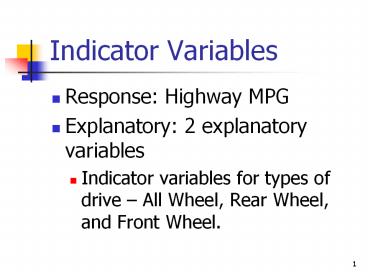Indicator Variables - PowerPoint PPT Presentation
1 / 27
Title: Indicator Variables
1
Indicator Variables
- Response Highway MPG
- Explanatory 2 explanatory variables
- Indicator variables for types of drive All
Wheel, Rear Wheel, and Front Wheel.
2
All Wheel Indicator
- All Wheel 1 if the vehicle has all wheel drive.
- All Wheel 0 if the vehicle does not have all
wheel drive.
3
Rear Wheel Indicator
- Rear Wheel 1 if the vehicle has rear wheel
drive. - Rear Wheel 0 if the vehicle does not have rear
wheel drive.
4
Front Wheel Indicator
- There is no need for a separate indicator
variable for front wheel drive. - If All Wheel 0 and Rear Wheel 0, then the
vehicle has front wheel drive.
5
Multiple Regression
- Fit a multiple regression model with the two
indicator variables as the explanatory variables
and Highway MPG as the response.
6
(No Transcript)
7
Prediction Equation
- Predicted Highway MPG 29.983
- 7.375All Wheel
- 3.454Rear Wheel
8
Summary
- R2 0.254
- adj R2 0.239
- RMSE 5.312
- Model is useful. F 16.5224, P-value lt 0.0001
9
Interpretation
- Estimated intercept When All Wheel 0 and Rear
Wheel 0 the predicted Highway MPG is 29.983. - The average Highway MPG for front wheel drive
cars is 29.983.
10
Interpretation
- Estimated slope for All Wheel Holding Rear Wheel
0, if you change All Wheel from 0 to 1 you are
comparing the Front Wheel drive to the All Wheel
drive. - An All Wheel drive vehicle gets, on average,
7.375 mpg less than a Front Wheel drive vehicle.
11
Interpretation
- Estimated slope for Rear Wheel Holding All Wheel
0, if you change Rear Wheel from 0 to 1 you are
comparing the Front Wheel drive to the Rear Wheel
drive. - A Rear Wheel drive vehicle gets, on average,
3.454 mpg less than a Front Wheel drive vehicle.
12
Comparisons
- Are the differences between All Wheel and Front
Wheel and Rear Wheel and Front Wheel
statistically significant?
13
Comparison
- All Wheel to Front Wheel.
- Difference in average Highway mpg is 7.375.
- t 5.66, F 32.05
- P-value lt 0.0001
- The difference is statistically significant
because the P-value is so small.
14
Comparison
- Rear Wheel to Front Wheel.
- Difference in average Highway mpg is 3.454.
- t 2.37, F 5.60
- P-value lt 0.0199
- The difference is statistically significant
because the P-value is so small.
15
Comparison
- All Wheel to Rear Wheel.
- This comparison is not considered in the JMP
output. - However, there is enough information to figure it
out.
16
Predictions
- All Wheel Predicted Highway MPG 29.983
7.375 22.608 - Rear Wheel Predicted Highway MPG 29.983
3.454 26.529
17
Comparison
- All Wheel to Rear Wheel.
- Difference in average Highway mpg is 22.608
26.529 - 3.921
- Is this difference statistically significant?
18
Test of Significance
- Difference in means
19
Summary
Mean Sample Size
All Wheel 22.608 23
Rear Wheel 26.529 17
Front Wheel 29.983 60
20
Comparison
- All Wheel to Rear Wheel
21
Comparison
- All Wheel to Rear Wheel.
- Difference in average Highway mpg is 3.921.
- t 2.31, F 5.33
- P-value 0.0231
- The difference is statistically significant
because the P-value is so small (lt 0.05).
22
(No Transcript)
23
Residuals vs. Predicted
- The predicted values correspond to the three
types of drive All Wheel, Rear Wheel and Front
Wheel. - Front Wheel drive vehicles show more variation
than the other types of drives.
24
Residual
25
Interpretation
- Histogram Mounded to the left of zero and skewed
to the right. - Box Plot Skewed right with one potential outlier
on the negative side and several potential
outliers on the positive side.
26
Interpretation
- Normal Quantile Plot the points start off
following the red diagonal (normal model) line
but then dip below, curve above and dip below.
This indicates a skewed right distribution.
27
Conditions?
- Equal standard deviation condition may not be
met. - Identically distributed condition may not be met.
- Normally distributed condition may not be met.































